Celebration in Curaçao
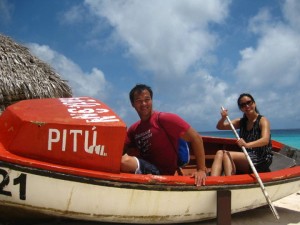
The day after our engagement, I took Irene on a getaway trip to Curaçao to celebrate. We had an awesome three days of hiking, scuba diving, trying new foods, sightseeing, and meeting new friends.
About Curaçao
Like Sint Maarten, Curaçao (pronounced “KUR-a-sao”) is part of the Kingdom of the Netherlands, but is so different from St. Maarten in terms of culture, language, infrastructure, and landscape. The island is much larger than St. Maarten, nearly five times bigger, and has a population of about 142,000. Unlike St. Maarten where the population is more or less distributed evenly across the island, Curacao has one big city where most people live, and a lot of countryside on the rest of the island. It makes Curaçao an awesome place to both explore nature and enjoy a night out on the town at the same time.
Landscape: The Desert of the Caribbean
Curaçao is quite different from what you would normally picture as a Caribbean Island. Geographically a part of South America, it has a dry and desert-like landscape and a dramatic rocky coast along most of its shore line. There are more cacti than palm trees, and the mountains look more like mesas and buttes found in the American southwest. But juxtaposed to this harsh landscape are beautiful hidden jewel beaches with blue water and a unique, colorful culture that blends, Dutch, Latino, and Afro-Caribbean culture.
Culture: Latin + Dutch = Curaçao
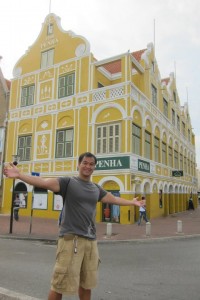
While St. Maarten’s culture is much more influenced by Afro-Caribbean culture, Curaçao’s culture has much more Latino and Dutch influence, probably because of its proximity to Venezuela (actually, you can see Venezuela from Curaçao on a clear day) and closer historical ties to European Holland. The most common language spoken on the street is not English, but Papiamentu, a unique language derived from Spanish and Dutch, spoken nowhere else in the world but on Curaçao and a few surrounding islands. The language sounds very beautiful and colorful. The second most common language is probably Dutch, but in our experience we found there are many people who also know Spanish or English as well. The street signs, billboards, and advertisements are written mainly in either Papiamentu or Dutch, but sometimes you’ll also see English or Spanish. Unlike Calypso music in St. Maarten, a lot of the music you hear on the street or on the radio in Curaçao sounds Latin, but is often sung in Papiamentu. Curacao is one of the most multilingual societies I have been.
Infrastructure
In terms of infrastructure, Curaçao seems much more developed than St. Maarten (although St. Maarten by itself is already much more developed than most Caribbean islands). The streets are smooth, clean, and wide and there are multi-lane highways and large, spanning bridges. Much of Willemstad outside the downtown area looks a lot like any city in the United States (except with Papiamentu signs and Dutch street names), and like the United States, has its fair share of urban sprawl. While Curaçao has a vibrant tourism industry, its main source of economy is not tourism but oil refining, which contributes to its wealth, along with its closer historical ties to the Dutch motherland.
Willemstad: Dutch with Caribbean Charm
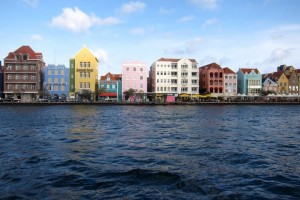
Downtown Willemstad, the capital of Curaçao (and once the capital of the now-dissembled Netherlands Antilles of which St. Maarten was a part), is a UNESCO World Heritage Site because of its well-preserved unique colonial architecture that blends Dutch structures with Caribbean colors. It’s a very beautiful and charming place, not to mention, a great place to shop and hang out.
We stayed at the Kura Hulanda Hotel in the Otrabanda district of Willemstad. Once a run-down part of town, it was restored to its former glory, closed-off from the rest of the city, and is now one of the nicest and most beautiful hotels in the Caribbean. The entire hotel is a little village, complete with outdoor cafes and restaurants, art galleries, fountains, town squares, alleys, and cobblestone streets.
Connecting Punda and Otrabanda, the two historical districts of Willemstad, is the Queen Emma Bridge. Built in 1888, it is unique in that it is a floating bridge, built on pontoons floating in the water. It swings open a few times a day to let ships in and out of the harbor, during which time ferries take passengers to the other side for free.
As Curaçao is right off the shore of Venezuela, Venezuelan farmers sail over every morning to the Floating Market in Willemstad to sell their fresh produce. Irene and I just discovered some of our newest favorite fruits!
Klein Curaçao
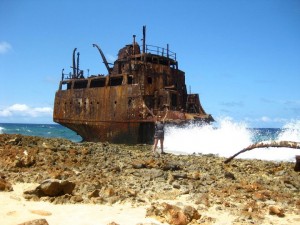
During our time on the island, Irene and I got to hang out with one of Irene’s friends from Georgia Tech, John, who lives and teaches on the island. He invited us to our new friend Amy’s birthday excursion to the secluded island of Klein Curaçao, an hour east by boat from Curaçao. Klein Curaçao is flat, dry, bare, and has no shade anywhere on the island except for some thatched huts by the beach, a shipwreck, and an abandoned lighthouse that dominates the landscape. This lifeless, horizontal world above is in stark contrast to what’s beneath the surface of the surrounding waters. An unusual feature of Klein Curaçao is that the seafloor drops down steeply, within just a few hundred feet from the shore. Irene, John, and I and a few others on the trip rented scuba gear from the mainland to explore this untouched vertical wall reef off of Klein Curacao. It was my first time diving a wall, with a bottomless drop off. The sea life here is absolutely amazing and untainted. We saw lots of different types of coral I haven’t seen before in my dives in St. Maarten. We even swam with a sea turtle!
Shete Boka National Park
Irene, John, and I actually didn’t originally intend to visit Shete Boka National Park. But because we didn’t know Mt. Christoffel National Park had opening hours, we ended up driving an hour to the other side of the island only to find out that Mt. Christoffel was closed to hikers at that time. John then suggested Shete Boka National Park, and I’m so glad we went. Shete Boka in the Papiamentu language means “seven mouths” and they refer to the seven inlets that cut into the rocky cliff shore on the northwest side of the island. These inlets is home to much wildlife as well as create a show of thundering waves. My favorite boka is the cave that you descend into and see the surf roll in, as well as the pistol boka where the clashing waves into the boka create an impressive pistol-like splash.
Mt. Christoffel National Park
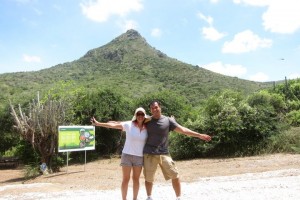
On our last day, Irene and I finally got up early enough and made it on time to climb Mt. Christoffel, the highest peak on Curacao. Hiking is the best way to experience nature, and Curacao has a very beautiful desert wildlife, with tall cacti, air plants, thorny shrubs, and divi-divi, Curaçao’s national tree with its elegantly twisty branches. The hike is fairly easy, taking only an hour each way and a gradual climb most of the way to the top. The last ten minutes literally required us to climb rocks, just on the edge of cliffs. It was a bit scary, but the view on top was worth the climb and risk. As Curaçao is mostly flat, we could see the entire island, and miles and miles of vista beyond.
Lots More to Do…
Curaçao is much larger than St. Maarten and there’s tons to see and do. Although Irene and I had an awesome three days of exploring Curaçao, there is still much more that we didn’t get to see or do, like visiting the ostrich farm, swimming with dolphins, cave exploring, or trying the best local Curaçaoan food at Plasa Bieu.
Check out the video I made of our trip!


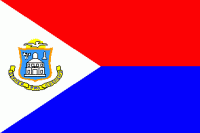











I love Curaçao..they actually have Wendy’s unlike Bonaire. I stopped by Curaçao on my way from Bonaire to Miami after I was done with Basic Sciences at SJSM.
Wow, Wendy’s? We don’t even have Wendy’s in St. Maarten. I could go for a Frosty…
Good luck in Clinicals!
What a lovely thoughtful blog – I found it searching ‘exploring otrabanda’ and read all of your post as well as many others. Very interesting. I am working in Curacao right now and starting to really love this island.
Congrats on your engagement – you seem like a lovely couple with so much ahead of you. Thanks for sharing your experiences & being so positive about everything!
Hey Benji
I am trying to find a flight between Curacao and St Maarten. What airline should I use?
Jarin
Hi Jarin,
The two airlines that travel between Curacao and St. Maarten are Dutch Antilles Express (DAE) and Insel Air. When Irene and I took DAE, we had a 6 hour delay without any notification, so I question their reliability. I haven’t heard anything bad about Insel Air, so I’d recommend going with them.
Benji